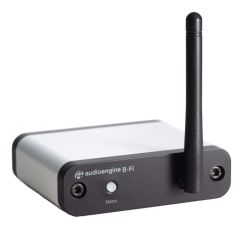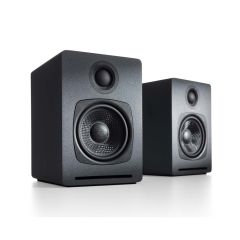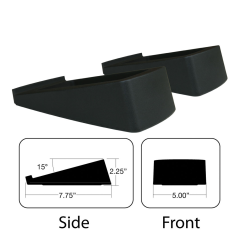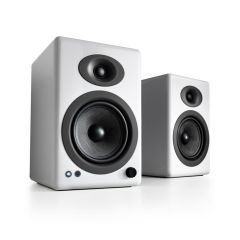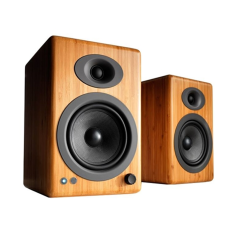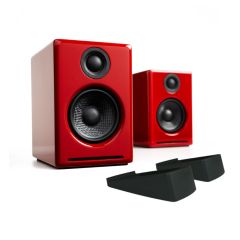GENERAL SPECIFICATIONS
Type
2.0 powered (active) bookshelf-style speaker system
Power Output
150W peak power total (50W RMS / 75W peak per channel), AES
Inputs
3.5mm stereo mini-jack, RCA L/R
Input Voltages
115/240V, 50/60Hz manually switchable
Amplifier Type
Dual Class AB monolithic
Drivers
5″ aramid fiber woofers, 3/4″ silk dome tweeters
SNR
>95dB (typical A-weighted)
THD+N
<0.05% at all power settings
Crosstalk
-50dB
Frequency response
50Hz-22kHz +/-1.5dB
Input impedance
10K ohms unbalanced
Protection
Output current limiting, thermal over-temperature, power on/off transient protection, replaceable external main fuse
Power Consumption
Idle: 10W
Mute: 6W
Sleep: 4W
BLUETOOTH SPECIFICATIONS
Internal D/A converter
AKM AK4396
Input bit depth
24-bits upsampled
Bluetooth receiver type
Bluetooth 5.0 audio
Supported codecs
aptX HD, aptX low latency, aptX, AAC, SBC
Wireless operation range
Up to 100ft (30m) typical
Input data rate
Determined by Bluetooth
Wireless latency
~30 milliseconds (ms)
WEIGHTS AND MEASURES
Dimensions (each speaker HWD)
Left – 10.75″ (27cm) x 7″ (18cm) x 9″ (23cm)
Right – 10.75″ (27cm) x 7″ (18cm) x 7.75″ (20cm)
Weight (LEFT speaker)
15.4 lbs (7 kg)
Weight (RIGHT speaker)
9.6 lbs (4.4 kg)
Shipping weight
31 lbs (14 kg)
Shipping box dims
15″ (38cm) x 22″ (56cm) x 11.5″ (29cm)
ENVIRONMENTAL REQUIREMENTS
Operating temperature: 32 degrees F to 95 degrees F
Non-operating temperature: -4 degrees F to 113 degrees F
Relative humidity: 5% to 95% non-condensing
MATERIALS AND CONSTRUCTION
1/2″ (13mm) thick MDF cabinets
5″ (130mm) aramid fiber woofers with advanced voice coils
3/4″ (20mm) silk dome tweeters with neodymium magnets
Toroidal power transformer
INCLUDED ACCESSORIES
(1) Remote control
(1) Antenna
(1) Speaker wire (16AWG), 4 meters (~13ft)
(1) Detachable AC power cord
(1) Mini-jack audio cable, 2 meters (~6.5ft)
(1) RCA audio cable, 2 meters (~6.5ft)
(2) Microfiber speaker bags
(1) Microfiber cable bag
(1) Quickstart guide
(1) Product line brochure
CUSTOM BUILT
Audioengine designs and manufactures our own tweeters, woofers, and other critical components. In other words, these are not box built speakers with off-the-shelf parts but custom-designed to our specifications. What we do not fabricate directly in our factory we have made to our designs (parts such as transformers, magnets, and wiring harnesses, for example). The cabinets, drivers, bass port designs, amplifiers, and crossovers are all painstakingly tuned together for each Audioengine model. This, in turn, makes for a much more efficient system that requires much less power than passive speakers and a separate integrated amplifier or similar A/V components.
DRIVERS
Audioengine uses audiophile-quality, ferrofluid-cooled silk dome tweeters with neodymium magnets. Silk tweeters hold up well under high power and the edge-driven design gives very smooth response. The woofers are aramid fiber woven glass composite with rubber surrounds. Aramid fiber is obviously very strong, which means that the woofer retains its shape when being driven at high levels. The speaker materials and construction are robust enough to stand up to some serious thrashing, so speaker grills are not needed and they will sound and look great after many years of use.
POWER AMPLIFIERS
The amplifiers in Audioengine speakers are located in the left speaker and are a conservatively rated analog design. All components are tuned together for each model, which provides a much more efficient system requiring less power than passive speakers and separate amplifiers. Circuit boards for the power and preamp sections are mounted for maximum mechanical shock protection.
POWER TRANSFORMERS
Power transformers are a large contributor to the overall audio performance, especially in the low end. Again, no off-the-shelf parts. Audioengine uses gapless core toroidal transformers which have a tighter radiated magnetic field, directly translating to lower noise. They are lighter than standard, lower-cost transformers and also generate less heat.
SHIELDING
Both drivers are directly video shielded and allow the user to place the speakers within a few inches of a video monitor. This shielding also offers protection for hard-drive digital music players.
|



















